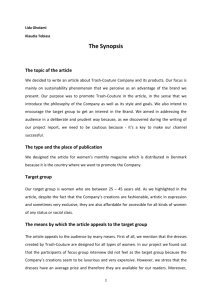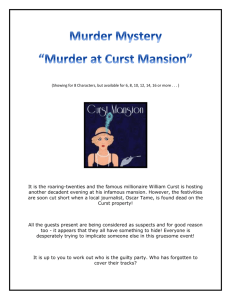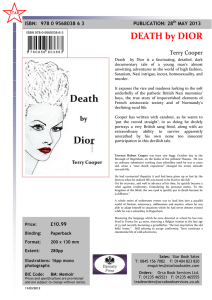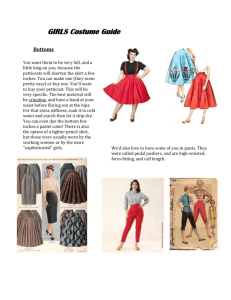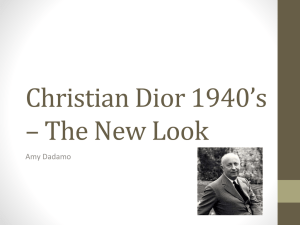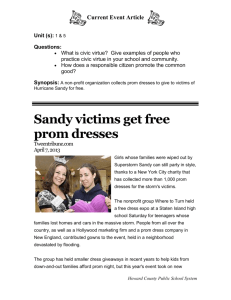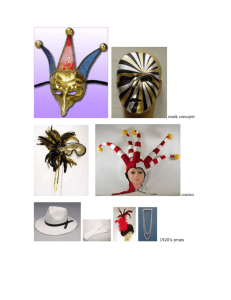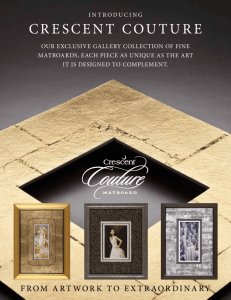Untitled - Palais Galliera
advertisement
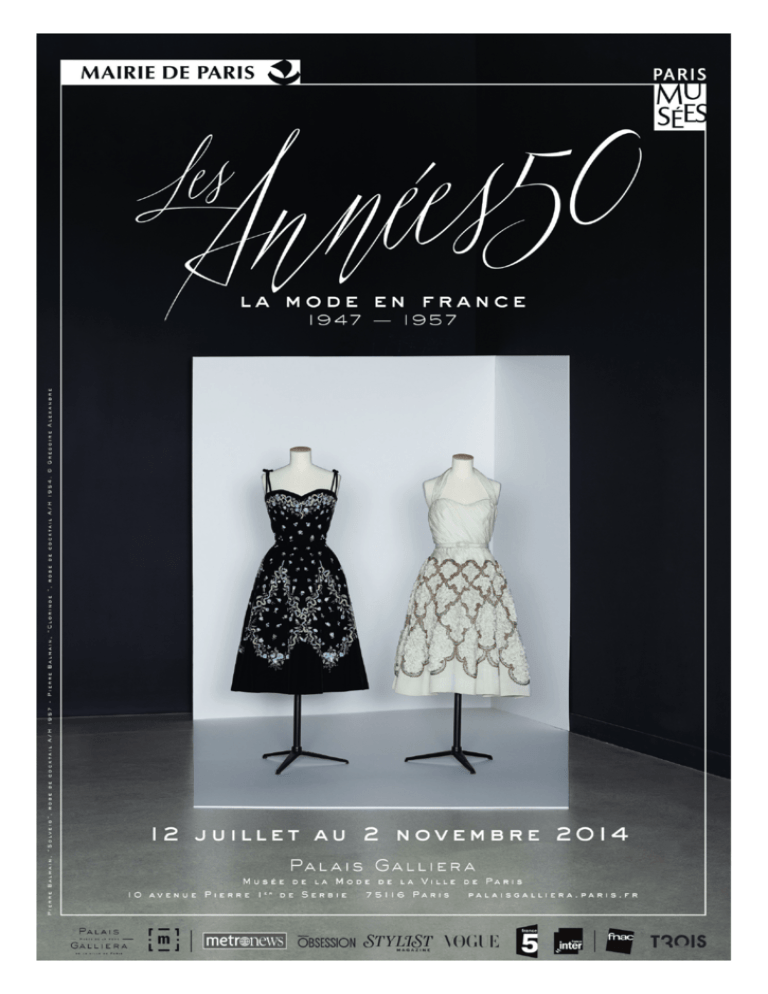
12 th july – 2nd november SUMMARY PRESS RELEASE p. 3 EXHIBITION DESIGN p. 5 EXHIBITION ITINERARY p. 6 Daytime wardrobe Evening wardrobe Casual dresses: Beach and sun dresses Foundation garments, underwear and lingerie Cocktail dresses p. 7 p. 11 p. 13 p. 14 p. 15 CATALOGUE p. 17 CATALOGUE EXTRACT: SUPERSTAR COUTURIERS by Olivier Saillard p. 18 GRAND ACTION CINEMA p. 21 ACTIVITIES FOR THE YOUNG ONES p. 22 USEFUL INFORMATION p. 23 PRESS OFFICE Anne de Nesle, Caroline Chenu Assisted by Mélisande Vialard Tél. +33 (0)1 56 52 86 08 presse.galliera@paris.fr Press images on request 2 12 th july – 2nd november press rele ase Basques, petticoats, corolla skirts, pointed shoes, bright-coloured floral and striped prints, wasp-waist suits with straight skirts, strapless sheath dresses, cocktail dresses, rock crystal embroidery: such was the couture of the fifties. At the same time, though, a more relaxed style – close-fitting pullovers, pedal pushers, jeans – was being adopted by the baby boom generation. Early in 1947, Christian Dior launched his fashion house’s first collection. The war had come to an end and with it the image of the ‘soldier girl with a boxer’s build’. In her place came Dior’s ‘woman-flower’, with prominent bust, cinched waist, flat stomach, rounded hips and very full skirt. Immediately dubbed the ‘New Look» by Harper’s Bazaar editor in chief Carmel Snow, the ‘hourglass’ figure and its extravagant demand for fabric created a furore – but also met with the instant, dazzling success that made it the emblem of the decade. Other competing styles were just as remarkable: Balenciaga’s ‘barrel’ line with its flared back and waist; and, at the opposite pole from the New Look, the dramatically innovative Chanel line of 1954 with its simple, straight suits. The 1950s were a decisive period for French haute couture, which had suffered badly in the wake of the 1929 stock market crash and the war and was now reborn and made eternal. The list of names says it all: Jacques Heim, Chanel, Schiaparelli, Balenciaga, Jacques Fath making up the old guard; followed by newcomers Pierre Balmain, Christian Dior, Jacques Griffe, Hubert de Givenchy and Pierre Cardin. Paradoxically the dominance of French fashion hinged not only on the prestige of names that spelled luxury, elegance and originality, but also on the profession’s willingness to make the revolutionary move into ready-to-wear. In 1954 the ‘Couturiers Associés’ – Jacques Fath, Robert Piguet, Paquin, Carven, Jean Dessès – founded the first haute couture ready-to-wear licensing company . Drawn from the Palais Galliera collection and sporting the labels of the most famous couturiers as well as others now forgotten (Jean Dessès, Madeleine Vramant, Lola Prusac), the remarkable pieces making up this exhibition – some 100 models and accessories – retrace the evolution of the female form through the decade 1947–1957: from the birth of the New Look to the death of Christian Dior and the advent of Yves Saint Laurent. 3 In the 1950s haute couture and ready-to-wear were one of France’s major economic sectors and a veritable fashion breeding ground. This was haute couture’s golden age, when Paris regained its title of world fashion capital. Curator Olivier Saillard, directeur du Palais Galliera Scientific curator Alexandra Bosc, conservateur du patrimoine, In collaboration with members of the Conservation of the Palais Galliera Christian Dior, Jacques Fath, Grès © Grégoire Alexandre 4 e xhibition design Grey stands and picture rails are interspersed throughout the exhibition’s thematic itinerary. The strict geometry of the design elements is inspired by 50s modernism. It highlights the extreme elegance of the exhibited silhouettes and contrasts with the museum’s architecture in order to emphasise it better. The design of the exhibition matches the layout of the venue: in the Reception Hall, a long free-standing wall with surround lighting stages the daytime wardrobe. The Grand Gallery brings together the evening dresses in four display cases, laid out one after the other, in an atmosphere reminiscent of a 50s ballroom. Swimsuits and lingerie are displayed like paintings on the walls of the small lateral galleries… Exhibition designer Julie Boidin © Julie Boidin 5 e xhibition itiner ary RECEPTION HALL, ENTRANCE In February 1947, the collection of a couturier, new to Avenue Montaigne, shifts the fashion landscape in France forever. Lithe models weave their way through the showrooms, wearing clothes that are nothing short of revolutionary, both in terms of length and shape. Long, full skirts with more petticoats than ever come as quite the shock after the years of restriction imposed by the Second World War. Excessively cinched waists imply a revival of corsetry, exaggerated basques give the restructured silhouettes great allure, narrow shoulders and full breasts represent a new femininity which will serve as a blueprint for the entire decade. On both sides of the Atlantic, this collection causes outrage. Four years after the so-called New Look collection, Christian Dior alone represents 49% of total French couture export revenue. His shows combine media success and prosperity. 50s fashion is dominated by male couturiers, whose worship of femininity is perceived as a magnificent means of expression but also a figurative cage for women. Jacques Fath is one of its craftsmen. Balenciaga, master amongst masters, creates the second half of the 20th century with the help of his scissors and structured fabrics. Others including Jacques Heim, Jacques Griffe, Jean Dessès and Antonio Castillo are soon joined by Pierre Cardin and Hubert de Givenchy to work towards the 50s ideal of elegance, which some still consider unrivalled. Mademoiselle Chanel rebels against this historical and archaic stylistic domination, orchestrating her own come-back. In 1954, aged 71, her collection, initially disdained but then acclaimed, consecrates her famous suit as a clothing alternative, the contemporaneity of which goes without saying. An androgynous silhouette takes shape and foreshadows the upheaval to come in the following decade. With Monsieur Dior’s sudden and untimely death in 1957 comes the end of an era; the extravagant repertoire of the 50s is over. “A face in the shadows, Yves the 21-year-old heir” headlines Paris Match.1 Yves Mathieu-Saint-Laurent, considered by Dior to be his spiritual heir, is promoted to creative director of the couture house. The figures tell another story. Out of 106 couture houses in 1946, 60 remain in 1952 and only 36 in 1958. The advent of ready-to-wear is just around the corner from the 50s, a decade which led to its development and the threat of democratisation it posed, a threat which haute couture will struggle to counter in a relevant and contemporary manner. This is most likely the reason why the 50s are an isolated decade in the history of fashion, their revival yearned forever since. 6 1. 9th November 1957 edition. CHRISTIAN DIOR On 12th February 1947, a few months after founding his couture house, Christian Dior launches his first collection. The models showcase pieces with rounded shoulders, tiny corset waists, emphasised hips; his skirts are considerably longer than in previous seasons, and more importantly perhaps, longer than those of other couturiers. With this return to feminine curves, inspired by the previous century, Dior yearns to escape the post-war era of “soldier women with a boxer’s build”. Almost immediately, Carmel Snow, editor-in-chief of Harper’s Bazaar, dubs these outfits New Look (new silhouette). Thanks to Dior, Paris reclaims its title of fashion capital of the world, after international buyers had been scared off by the Occupation. French women are delighted to rediscover their femininity and are able symbolically to turn the page on rationing and national humiliation. Christian Dior, “Bonbon” [Sweetie], Day dress, A/W 1947-1948 Wool-twill, metal buttons and animal-skin belt Palais Galliera Collection © Galliera/Roger-Viollet DAYTIME WARDROBE RECEPTION HALL Day suits, travel suits, classic suits, two-piece day suits, travel coats, everyday coats, lunch dresses, day dresses, formal day dresses, simple daytime ensembles, late afternoon dresses, end of the day dresses, outfits for entertaining, travel outfits, weekend outfits, cabaret outfits, indoor dresses, city dresses, evening dresses… In the 50s, a woman’s wardrobe was something of a dictionary, the subtleties of which are now akin to an endangered language: untranslatable and with no contemporary equivalence. Added to this vast glossary, which was motivated by the fashion industry and a professed consumerist desire, is an array of numbers and letters, the new blueprints underpinning the collections’ designs and shapes. The “8”, “H”, “A” and “Y” lines aren’t in fact mere gobbledygook. They dictate the movements and lengths favoured by the couturier for a particular jacket or dress. In the ateliers and showrooms, suits and other models are named “Auteuil”, “Promenade”, “Bernique”, “Esperanto”, “Raout” or “Rue des ciseaux”… This “seamstress” poetry, lamented by Chanel (who preferred the use of numbers) is broadcast through a plethora of images in new trendy magazines and in the new media. In the early 50s, many clients are still not privileged enough to frequent the showrooms of the 60 existing couture houses. A more democratic licensing system is thus set up, with more accessible collections (Jacques Fath University, Heim Jeunes Filles, Lanvin Boutique…). For everyone else, there are dressmakers (not particularly affable or refined) and patterns, available in magazines. Until the 60s, most women are seamstresses skilled in the reproduction of the models they cherish. Be it gloves, hat or handbag, accessories are vital to finish off an outfit. 7 BALENCIAGA “Balenciaga’s fashion, combining French sophistication and Spanish passion, is pure and balanced. Neither improvisation nor concession. His suits, with their revolutionary seams, are impossible to replicate and his sumptuous evening gowns are seemingly miraculously simple.” So is described the mysterious Balenciaga in a 1951 Paris Match article.1 “The invisible man of fashion” is described as an “enigma, which paradoxically helped his publicity more than the most scandalous of rumours”. The Spanish couturier who moved to Paris in 1937 favoured work over media coverge. His majestic collections were revered in his bare whitewalled showroom on Avenue Marceau. Across the Channel, the month of June means Royal Ascot, an event attended by none other than Her Majesty the Queen. Rita Hayworth, recently wed to Prince Ali Khan, is also amongst the guests. In the 1st July 1950 edition of Paris Match, dedicated to the event, the actress is shown wearing an exact replica of this suit. The wool-twill jacket and skirt are from couturier Cristóbal Balenciaga’s 1950 spring/summer collection. The cut is sober and clean, the way the pioneering Spanish couturier likes it. The only extravagances allowed are 10 buttons, one opposite the other, and the layering of double basques which give the suit a winged look and the feeling that one jacket is warming up another. This tapered line epitomises the new silhouette sought by Balenciaga. Balenciaga, Day suit, S/S 1950 Wool-twill Palais Galliera Collection © Galliera/Roger-Viollet CHANEL In the March 1954 edition of Le nouveau femina, Jean Cocteau pays tribute to Chanel’s return to the fashion scene: “If Mademoiselle Chanel has reigned over fashion, it is not only because she cut women’s hair, married wool and silk, wrapped pearls over jumpers, avoided poetic labels for her perfumes, lowered or raised the waist-line and made every woman follow her orders, it is because, on top of this gracious and robust dictatorship, she knew her era inside-out and worked as hard for what she had to offer in the present as for what she pondered for the future… Her return to the Parisian stage means so much more than the reopening of a great couture house. It illustrates the need to beat mediocrity.” Mademoiselle Chanel opened her couture house, as a milliner, in 1909. She changed the course of fashion history through the innovations cited above by Cocteau, as well, of course, as the famous little black dress (1926). Upon the announcement of the Second World War, she decided to close down. In 1954, at 71 years of age, Chanel comes back with stripped-down suits and androgynous silhouettes, leagues away from the creations of her contemporaries. Anglo-Saxon journalists and buyers welcome the modernity of her creations, whilst the French press ignores her before applauding the neo-classicism of her work the following season. The image of the suit becomes essential, for every season, at any time. Dresses become simpler. To this, Chanel adds the shoulder bag, two-tone sandals, and reinvents her own idea of elegance, not extravagant but nonchalant. Chanel, Day dress, S/S 1954 Wool Chanel archives © Chanel/Grégoire Alexandre 8 1. Uncovered for the first time – Balenciaga, the invisible man of fashion. Paris Match 18th August 1951. JACQUES FATH Jacques Fath’s couture house opens in 1937 but only really takes off in the 40s. It offers a light and cheerful fashion, full of imagination, which the creator sees as an extension of himself. In the press, he doesn’t shy away from putting on a performance, be it at a masked ball or stepping out of the bath – he understands the relevance of media exposure for the image of his brand. In the wake of the New Look pioneered by Dior, Fath plays with asymmetry and volumes, remodelling an idealised female figure, and lengthens the silhouette, be it for the evening or daytime. This afternoon dress, from the autumn/winter 1948-1949 collection, hints at the imagination of its creator, who uses the art of trompe-l’oeil to imitate a two-piece ensemble, by fake-buttoning a jumper and a skirt which are in reality but one. Jacques Fath, Day dress, A/W 1948-1949 Textured wool jersey Palais Galliera Collection © Galliera/Roger-Viollet JACQUES HEIM Having inherited the family business which specialised in fur, Jacques Heim branches out in 1925 and founds an haute couture department. In 1936, he opens “Heim Jeunes Filles” on the ground floor. Without uproar or scandal, the designer’s style borrows from French heritage with restraint and finesse, and is served by the expertise of renowned ateliers. Jacques Heim introduces into the realm of haute couture the use of hitherto despised fabrics such as cotton. He is also sparing with embroidery and effects, thereby appealing to a younger clientele and helping promote the budding ready-to-wear. In 1987, the Heim family make an important donation to the Galliera museum of archives, numerous pieces of clothing, drawings and photographs that bear witness to the creative energy of this couture house, which closes its doors in the 60s. CHRISTIAN DIOR Exhibitions can be a great way to discover hidden gems of designer clothing, as is the case with this suit which arrived at the museum seemingly brandless but which, thanks to research carried out in collaboration with the Christian Dior couture house, was properly identified. The suit is made up of a dress and jacket, the original drawings for which were found in the 1950 autumn/ winter collection archives of the couture house based on Avenue Montaigne. “Bernique” owes its name to its shell or conical Asian hat shape, which boldly extends from the jacket into a flared basque. Fitted and clean-cut, it is the perfect embodiment of the spirit of both the couturier himself and the 50s. Four years after the New Look revolution, Christian Dior alone represents 49% of the total French couture export revenue. The 1950 autumn/winter collection comprises 191 models, 64 coats and 23 furs. There is no alteration to length, but there is a shift towards bias cuts. Natural curves are re-established: sloping shoulders, “augmented” bust, narrow waist and accentuated hips. According to Paris Match (12th August 1950 edition), “350 lucky people attended the premiere of Dior’s show, 240 in the grand and small showrooms, 40 on the landing, 40 on the staircase and 30 standing (…), 12 models walked the catwalk for three and a quarter hours”. That day, proud and elegant “Bernique” snuck into the Avenue Montaigne showrooms and was admired by all present. Jacques Heim, “Sophie”, Dinner dress, A/W 1947-1948 Polka-dot print silk taffeta Palais Galliera Collection © Galliera/Roger-Viollet Christian Dior, “Bernique” [Limpet], Daytime ensemble, A/W 1950-1951 Worsted wool Palais Galliera Collection © Galliera/Roger-Viollet 9 CARVEN Carven, “Esperanto”, day suit, S/S 1951 Worsted alpaca wool, black horsehair braiding Palais Galliera Collection © Galliera/Roger-Viollet The Carven couture house saw the light of day in a Champs Elysées apartment in 1944. Bearing in mind that couturiers of the time only dressed tall slender women, founder Madame Carven decided to address an equally elegant clientele, albeit more petite, like herself. Consequently, Carven soon became a hit with young girls. Her fashion reflects this. She introduces more modest and lighter fabrics such as cotton and linen into the haute couture industry, which is more accustomed to silks. In 1950, Carven joins Dessès, Fath, Paquin and Piguet in the “Associated Couturiers”. The 5 couturiers work together with seven manufacturers, each of them producing 2 city dresses, 3 coats including one raincoat and 2 suits every season. The distribution of these models at affordable prices in regional boutiques heralds the advent of ready-to-wear. In the “Esperanto” suit, made from white Buche alpaca wool, the bust is covered in Rébé black horsehair braiding, which criss-crosses over a constricted body. This is the body of a 1951 woman, whose silhouette is ultrafeminised by the New Look revolution. The structure highlights the bust and waist by flaring the jacket’s basques with padding, a trick taken straight from the “Bar” suit from the first Dior collection. GIVENCHY Givenchy, “Ecosse”, Afternoon dress, S/S 1953 Printed Costa silk satin designed by Brossin de Méré. Palais Galliera Collection © Galliera/Roger-Viollet Pierre Cardin, Day suit, A/W 1958-1959 Black and white wool jaspé Palais Galliera Collection © Galliera/Roger-Viollet “This is the joke in Hubert de Givenchy’s collection; the simple silk dresses, youthful and cheerful, feature green peas, pineapples, grapes, etc. The fabrics used were created for the young couturier by Madame Brossin de Méré. Parisian women saw, welcomed and adopted the dresses within five minutes.” A double-spread in the March 1953 issue of Elle 1 presents them like tasty fruit on a market stall. Flowers of all shapes and sizes, fruit and vegetables, polka dots, stripes and animal prints in bold and bright colours are telling clues to the clientele’s hunger for fashion. Hubert de Givenchy, who opened his couture house in 1952, is a young and daring couturier. From his experience with Schiaparelli, he seems mainly to have retained a sense of boldness. From his collaboration with Lucien Lelong and Jacques Fath, he has kept a feel for elegance. Additionally, he is able to correct the excesses of his era with his sense of proportion and stylistic restraint which will soon come to epitomise his style. PIERRE CARDIN Pierre Cardin is popular for his futuristic clothes with which he invented 60s and 70s fashion. Yet the visionary couturier founded his company in 1953, after having been a part of the Dior adventure in 1947. An excellent designer and tailor, he is said to have cut and assembled the famous Bar Suit under Christian Dior’s supervision. He eventually leaves Dior after three years of collaboration and concentrates on creating theatre costumes and ballgowns. He also devotes himself to suits and coats, yet another task he excels at. Cardin is one of a breed of designers who know how to draw, cut and sew. In 1958, he personifies this new generation of fashion designers. His technical knowledge, along with his research into new materials, make him the heir of the 50s, yet he will be instrumental in the stylistic shift to come. The use of tweed as well as the length of the skirt and of the sleeves mark this suit as belonging to the 50s, which are drawing to a close. The generous design of the cape collar, combined with the absence of frills, bar one single rolled-fabric rose, already foreshadow the 60s and their target of simplification. 10 1. Elle, No. 383, 30th March 1953, “The New Trompe-l’œil” EVENING WARDROBE GRAND GALLERY Cortege dresses, garden-party dresses, bridesmaid dresses, cocktail dresses, early evening dresses, eating out dresses, dinner dresses, dancing dresses, gala dresses, grand gala dresses, summer dresses, evening dresses, evening attire, evening sheath dresses, evening gowns, formal evening gowns, formal robes… “Evening gowns are a luxury for couturiers. They are an outlet for their imaginations. They usually represent around one tenth of a collection.” 1 Be it Balmain, Dior, Fath, Schiaparelli or the master Balenciaga, they all outdo themselves when it comes to long gowns. Mermaid dresses, sheath dresses or, at the other extreme, very loose dresses, they all embody the mastery and the vivid imagination of each couturier. Heavy noble fabrics such as taffeta, satin and velvet, light diaphanous layers of tulle and chiffon, along with spidery lace make up the skirts of women whose society life still justifies such attire. Evening gowns in subtle or theatrical hues allow couturiers to become inspired painters, or sculptures of ephemeral pieces. Bustiers, plunging or draped necklines embellish busts. Long gloves amplify languid movements. The jewellery is spellbinding. Truly cinematic, these dresses are increasingly longer, flowing in follies of fabrics and in trains. Idolised models such as Anne Saint-Marie, Bettina, Dorian Leigh, Dovima and Suzy Parker showcase the splendour of historically reminiscent pieces. Soon after, these pieces will voluptuously envelop actresses whose role we are no longer sure is the lead or supporting part. GRÈS Madame Grès was renowned in the 30s and 40s for her clever draping, finely deployed on both evening and day dresses. The pleats she creates and arranges in her ateliers become so renowned that some describe them as true masterpieces. The 50s and 60s unjustly obscured the persistence of Madame Grès’s work. Less prominent in the press of the time, the fact remains that her dresses are entirely unique. Her technical knowledge and her sculptural approach to fabrics lead her instinctively to create dresses which are simultaneously sharp and extremely fluid. She has no use for padding or make-weights when working on the comfortable yet refined volume of her creations. She uses a fine silk jersey mixed with viscose to create her pleated evening gowns. However, this bustier evening gown is one of the rare examples to showcase the couturier’s pleating skills in a different cloth: a two-tone silk velvet in hues of beige and wild rose. The lengths of velvet used for the skirt are maintained by herringbone pleats on the hip, and fall in drapes thus sculpting deep asymmetric side pleats. Grès, Bustier evening gown, A/W 1956-1957 L. Bodin two-tone silk velvet Palais Galliera Collection © Galliera/Roger-Viollet 11 1. Paris Match, 2nd September 1950 edition. JACQUES FATH The secret of Jacques Fath’s success is his ability to instill his youth and extraordinary gaiety into his dresses. Since he founded his couture house in 1937, the couturier has exaggerated the curves of the hips and bust, thus preparing for the New Look revolution. He dares to use colour. The strict pre-war elegance is replaced by a style brimming over with joie de vivre. He surrounds himself with fresh talent and new faces, like Bettina who will be his muse for several years. If not asymmetric, designed free-hand and cut by a sharp and quick pair of scissors, his dresses venture towards other colours and materials. Such is the case with this ball gown, whose white tulle is but a means of showcasing a rather facetious bustier, embroidered with corn seeds. Jacques Fath, Ball gown, circa 1950 Synthetic tulle, silk chiffon, silk satin embroidered with metal thread, glass and resin beads, and corn seeds Palais Galliera Collection © Galliera/Roger-Viollet PIERRE BALMAIN The typical 50s evening gown with its bustier and long full skirt is a wardrobe staple. No matter what fabrics are used, it is reminiscent of the 18th century hoop skirt. Hidden corsets from the past are echoed by bodices and girdles which constrict and shape the body. Couturiers Pierre Balmain, Christian Dior and Jacques Fath were greatly inspired by the Age of Enlightenment. They rediscover the splendour of satin, taffeta and velvet which fashion retailers liked to decorate with ribbons and many a frill. Balmain, who opened his couture house in 1945 after having worked with Piguet and Lelong amongst others, remains faithful to this influence in both his cocktail dresses and evening gowns. “Antonia”, whose exact replica was worn by actress Edwige Feuillère, is the perfect illustration of history-inspired embellishment and shape. The metal thread embroidery at the heart of the dress and the chiffon roses celebrate this revival of History in 50s fashion. CHRISTIAN DIOR Pierre Balmain, “Antonia”, Evening gown, S/S 1954 “Orlon” satin, embroidered with silk and metal thread and cellophane, appliqué silk chiffon flowers Palais Galliera Collection © Galliera/Roger-Viollet Christian Dior, “Soirée Galante” [Romantic Evening], Evening gown, A/W 1955-1956 Lahondès silk satin Palais Galliera Collection © Galliera/Roger-Viollet The press release for Dior’s 1955-56 autumn/winter collection starts thus: “It is yet another letter, Y this time, which expresses the essence of the new collection… A high bust blossoms between the two branches of the Y which, in turn, end with natural and petite shoulders…” Opposed to a desire of slenderness are “numerous faille skirts which froth, roll, take shape and balloon in true turquerie style”. Colours to watch for the evening include pinks, pale blues and whites, “from Isabelle to Ivory”. Presented in the “Long evening gowns” category, “Soirée galante” is worn by model Victoire Dautreleau on the catwalk. With her short, spiky hair and pout, Victoire’s youth is surprising. She works in collaboration with Dior before following Yves Saint Laurent into the successful 60s with which she is commonly associated. 12 JEAN DESSÈS Jean Dessès (1904-1970) – whose real name was Jean Demètre – is a Greek couturier born in Alexandria. After studying Law, he soon shifts his focus to fashion and opens his couture house in 1937. Post-war, he sculpts draped evening gowns, with large pleats, the colours of which range from plain to subtle contrasting shades. Bar his skilful draping, there are no other references to the Antiquity in his creations, as shown by this evening gown, praised in the September 1956 edition of French Vogue. Far from the image of Greek caryatids, characterised by biomorphism, Jean Dessès uses pleated chiffon for his chrysalis dresses. Jean Dessès, Evening gown, A/W 1956-1957 Lamarre silk chiffon and silk velvet Palais Galliera Collection © Galliera/Roger-Viollet JACQUES HEIM Much of couturier Jacques Heim’s work has been archived here at Galliera and is ripe for rediscovery. Heim supported the work of both Sonia Delaunay and Dora Maar who designed the couture house’s logo and advertisements. An art aficionado and collector, the couturier started a rare periodical in which he was able to express his love of art. Heim’s couture house stands out for its great quality of work, which means high-quality ateliers. The style is sober, with no unnecessary frills. Jacques Heim’s dresses are not imposing, but rather discreetly elegant. CASUAL DRESSES: BEACH AND SUN DRESSES EASTERN GALLERY Beach dresses, holiday dresses, sun dresses, resort dresses, pinafores, striped jerseys, blouses, Capri pants, shawls, beach outfits, bathrobes, dungarees, canvas trousers, shorts, sarongs, swimsuits, straw hats… Jacques Heim, “Niagara”, evening gown, A/W 1952-1953 Two-tone silk satin Palais Galliera Collection © Galliera/Roger-Viollet Early in the 50s, the younger generation is struggling to identify with the diktats of haute couture. The search for refinement and elegance is taken to the extreme and more often than not transforms clothing into a luxury prison. To the amusement of Brigitte Bardot and Françoise Sagan, who share magazine covers and front-pages, a cheerful clientele proclaims an emancipated summer wardrobe which favours fresh tailored cotton. Wide-striped afternoon dresses, umbrella skirts in contrasting prints, exotic-flavoured beach outfits – all are appealing because of their comfort. Gone are the stiff fabrics, ribbing and structure of evening gowns. These clothes, worn close to the skin, are at the service of both the body and the sun. Flat ballet pumps which don’t hinder walking or dancing are also key in this search for spontaneity. Manufacturers take on the production, couture houses develop their own ranges. This summer fashion, worn in town as well as by the seaside, is also an experimental platform and a stepping stone for the budding ready-to-wear which truly comes of age in the 60s. 13 HERMÈS In the May 1952 edition of French Vogue there is a photograph of the “Hermeselle” dress, captioned as follows: “Whereas we usually use a print as the inspiration for creating a dress, Hermès does the exact opposite. In collaboration with Léonard fabrics, he offers a unique dress, the cut of which determines the design process. The print on a light background is akin to a stroke of charcoal; on a dark background, to gouache. This trick of the eye is what makes this dress so exclusive. It is available in cotton gabardine, wild silk and poplin, and in myriad colours. It comes with a leather belt and a cotton band of the same colour. This dress, the fastening of which is as much an illusion as the rest, can be purchased at Hermès and its branches in Cannes, Biarritz and Deauville…” Hermès, “Hermeselle”, Summer dress, S/S 1952 Printed Léonard cotton poplin Palais Galliera Collection ©Galliera/Roger-Viollet Lanvin-Castillo, Bayadere bustier dress, circa 1955 Striped cotton serge, “mattress-ticking” style Palais Galliera Collection © Galliera/Roger-Viollet LANVIN-CASTILLO Jeanne Lanvin died in 1946, aged 79, at which time, 1,500 women were working hard on the collections near Faubourg Saint-Honoré. In 1950, Spanish couturier Antonio Canovas de Castillo joins the Lanvin couture house and becomes it creative director. Exiled after the 1936 revolution, Castillo moved to Paris where he worked, pre-war, as a designer for Paquin, and then Piguet, when Elisabeth Arden summoned him to New York. He was also Mademoiselle Chanel’s right arm. When asked about him, Chanel said the following: “He is a sort of hidden genius. You have to be a ferret to get him out of his hole. And then, it’s just wonderful…” Antonio Castillo designed Lanvin’s collections until 1963. Throughout the 50s he endeavoured to bring back the colours and embroideries that Lanvin’s founder had been so fond of. He gave a contemporary take on the models of one of the oldest couture houses and sought to declutter, his style embodied by cuts that were sober, at times even austere. Yet his love of bold colours and patterns has always hinted at his Iberian roots. FOUNDATION GARMENTS, UNDERWEAR AND LINGERIE WESTERN GALLERY Bodices, girdles, corsets, balconnette bras, balconnette sets, slips, bras, control pants, panties, stockings, tights… In the 50s, daytime and evening outfits are the spitting image of the couturiers’ stylised drawings. Rounded shoulders topping a narrow bust. Hips blooming under strangled waists. Narrow, slim legs, like strokes of a pencil. Since 1947, women have been aware of the array of underwear required, something which is currently undergoing a genuine revival. This underwear shapes and structures the silhouette, as dictated by the couturier’s drawings. Slimming bodices tighten the waist. “Tipping” girdles narrow down the hips and constrict the back. Demi-bras neatly define the breasts, allowing for plunging cleavages. Lingerie introduces elusive and curved lines. “Petticoats are particularly popular. They are the must-have accessory of any wardrobe. Made out of cambric, Swiss muslin, cotton or lace, they are enhanced with ribbons. They are worn in conjunction with matching tops, which may or may not be underwired. Their volume is what gives skirts that particularly full aspect.” 1 The days of standard stockings are 14 1. Vogue. over. Embroidered, printed or encrusted, and/or matched to the outfit, nylon stockings adorn the legs of elegant women. This new designer corsetry is reminiscent of the past. Girdles are evocative of corsets. Three colours, black, pink and white, are used for this lingerie which the 60s will banish. It won’t be until the 80s, under the influence of Chantal Thomass, that it will be revived. COCKTAIL DRESSES SQUARE ROOM Early evening dresses, eating out dresses, dinner dresses, dancing dresses, cabaret dresses, evening dresses… Nowadays absent from catwalks, magazine pages and everyday wear, cocktail dresses sum up 50s women’s fashion. They are the natural evolution of early evening dresses from previous decades. They appeared in the aftermath of the war and disappeared with the advent of ready-to-wear, the following decade. Of varying lengths, they are somewhat less formal evening dresses. With more or less volume, they are evocative of afternoon dresses, though glorified by precious fabrics. They are automatically associated with a bustier cut, with or without straps, but can also have ¾ sleeves or be worn with a matching jacket. Cocktails dresses are worn “as early as 8pm for dinner, going out to a restaurant or the theatre; their shape coupling elegance with practicality… Spencers, boleros, scarves and coats can be used to cover bare shoulders until it becomes acceptable to reveal them”. 1 A true archetype of the fashion photographed and conveyed by the film industry, cocktail dresses disappear in 1964 with André Courrèges’s new wardrobe, at odds with the past. The youth of the time sees them as enslaving women, who are reduced to caring only about their appearance. It is not until the 80s that they will once more become an inspiration for designer collections. PIERRE BALMAIN Pierre Balmain, “Clorinde”, Cocktail dress, A/W 1954-1955 Ivory silk chiffon and metal thread embroidery Palais Galliera Collection © Galliera/Roger-Viollet Pierre Balmain’s dresses were cut according to the curvy silhouettes of the likes of Praline and Stella. House models and muses of a brand born in 1945, they are the image of femininity given to readers by magazines. Balmain’s success lies in his restrained approach to fashion. He appeals to clients who do not want to hide behind an excessively oppressive style. Since the autumn/ winter 1952-53, his collections are named “Jolie Madame” [Pretty Lady], after the eponymous perfume. It is more than a slogan. Pierre Balmain’s fashion accompanies women, be they models, celebrities, actresses or clients. It never takes over, discretion being a founding principle of the couturier’s ever graceful creations. 15 1. Vogue. October 1950. Pages 132-133. CHRISTIAN DIOR by Yves Saint Laurent Christian Dior by Yves Saint Laurent “Aurore”, Short evening dress, S/S 1958 Aurore de Lajoinie faille Palais Galliera Collection © Galliera/Roger-Viollet For his first collection Yves Saint Laurent, aged 21, introduces the “trapeze” line. The young couturier succeeded Dior, who tragically died in 1957 after ten years of creations which radically changed the image of fashion. Faithful to the Dior spirit, Yves Saint Laurent relies on the optical language of lines and seams that his predecessor enjoyed renewing. Models wear “Printemps” [Spring], “Porcelaine” [Porcelain], “Séduction” [Seduction], “Refrain” [Chorus], “Café de Flore” and “Zouzou”. These are the names chosen by the young designer for the organdie dresses, tulle skirts, wool or flannel suits which accompany his first steps. All the pieces incorporate this trapeze shape, from which slender female legs extend like rare flower stems. “Aurore”, of which there exists a Delft blue version in the Dior archives, belongs to the stylistic repertoire of the 50s from which Yves Saint Laurent will depart when he leaves Dior in 1960. BALENCIAGA In 1958, ten years before Cristóbal Balenciaga’s couture house shuts down, the Spanish couturier introduces the world of Parisian fashion to “Baby doll”. The shape is extremely simple. The proportions are somewhat surprising and the dress would most likely be described as “oversize” nowadays. The high neckline at the front, weighed down by the fabric, the round back and the lack of sleeves highlight the importance of the cut. Its disproportionate volume and its 1920s-doll-dress-style pleats are the main features of this new silhouette. The supple and fine taffeta is light as a feather and reveals the body subtly instead of hiding it, as the volume might suggest. Its originality and radicalism foretell of the reforming and simplifying trends of the 60s. In his 1958 collections, Balenciaga uses Directoire and Empire historical references. There are no rules other than mastery and technique. Balenciaga, “Baby doll”, Cocktail dress, S/S 1958 Taffeta Palais Galliera Collection © Galliera/Roger-Viollet 16 catalogue The Fifties. Fashion in France (1947-1957) Edited by Alexandra Bosc Texts by Véronique Belloir, Alexandra Bosc, Jacqueline Dumaine, Nathalie Gourseau, Alexandra Palmer, Sylvie Roy, Olivier Saillard and Ykje Wildenborg 272 pages / 230 colour illustrations 21.5 x 29 cm, hardback €44.90 Paris Musées Publishing ISBN 978-2-7596-0254-4 Catalogue presentation This catalogue provides an incredibly thorough account of the exceptional decade that was the 50s. The changing outlines and the structuring of the body are studied chronologically, thus providing an understanding of the evolution of the “perfect silhouette”. Readers will get “inside knowledge” through a series of accounts by saleswomen and journalists regaling them with tales of catwalk shows. Through the use of period articles, the publication also touches on fashion for a younger clientele as well as on the advent of ready-to-wear. Containing numerous textual references, articles from high-end magazines such as Vogue or more popular ones like Elle, interviews with contributors of varying degrees of fame, as well as case studies, this catalogue reveals to readers not only an inimitable style, but also an array of industry secrets, from Christian Dior’s economical approach to Jacques Fath’s enterprising style. Photos by great photographers of the time and archive documents are coupled with the Palais Galliera collections to offer a new and fascinating perspective on the celebrated decade. Talented contemporary photographer Grégoire Alexandre’s personal take on the repository of the Fashion Museum of the City of Paris concludes this exceptional iconography. Paris Musées Publishing Paris Musées is an art book publisher that publishes around thirty books a year – exhibition catalogues, museum guides, and journals – all beautiful books that reflect the wealth of the museums of the City of Paris and the variety of their temporary exhibitions. www.parismusees.paris.fr 17 catalogue e xtr act superstar couturiers olivier saill ard, directeur du pal ais galliera “The two names on everyone’s lips in the world of Parisian haute couture are Dior and Fath. Dior remains the champion, but Fath is not far behind. Dior is secretive, intimate, mysterious; Fath is friendly, a joker and a party animal. Everyone in the couture house, right down to the lowliest employee, knows Fath simply as Jacques. Dior, even to his closest collaborators, is none other than “Monsieur Dior”. The work of both men is a reflection, albeit in different ways: Dior’s is a contemplation, Fath’s a glint of light. Their common denominator is the conquest of America, which they achieved side by side. In 1950, an article published in Paris Match broaches the media battle between the two couturiers at the pinnacle of their fame. 1 The article, illustrated with photographs of “Bobby”, “Alfreda”, “Mon chou” [My darling], “Entrevue” [Interview] and “Canaille” [Rascal], a selection of suits, dresses and outfits from Dior and Fath’s collections, attempts to paint the portrait of the two top couturiers of the time. “He [Christian Dior] has a pointy nose, round cheeks, his face at once spiritual and eager, not too dissimilar to a fictional character […]. His true revolution, “New Look”, dates back to 12th February 1947 […]. Women immediately see in him a prophet […]. Dior is the reverie of a solitary wanderer. Fath, on the other hand, is a romantic novel. He is not yet forty; tall, handsome, athletic, a daredevil and a competent skier and swimmer […]. He was always destined for couture […] and became one of the most “worn” names in the United States.” The article is accompanied by a set of dated black-and-white passport photographs. In them, Christian Dior avoids the photographer’s gaze and glances sideways. His upper lip seems to swallow the lower one, in a shy childish gesture. Jacques Fath, on the other hand, is laughing straight at the camera. His beguiling smile, dimples and sun-kissed face catch the reader’s attention. He is a photogenic seducer. Both men play the part of modern couturiers with roaring success, and use the press and television to their advantage. The embodiment of elegant 50s style, both masters tragically die in the same decade. 2 Their clothes, from the initial drawings to the end product, epitomise post-war fashion. These designers whose faces are known to all split the 20th century right down the middle, relegating previous trends to the past and reaffirming the principles of haute couture elegance, which is drawing its final breath. The eagerness of newspapers and magazines to connect with them is telling of a new type of couturier, who cares not only about his collections but also about his public image. Ever present on the covers of magazines, they herald the reign of superstar designers in years to come. They are also the heirs of a long history which has seen the status of their profession and of their art drastically evolve towards greater recognition. 18 When Charles Frederick Worth 3 invents the haute couture industry in 1858, he considers himself an artist. He signs his creations on the waist ribbon, like painters sign their canvases. Live models to showcase collections, staged catwalk shows and seasonal renewal are other visionary ideas which the British couturier commands. The second great pioneer in the history of fashion, Jacques Doucet, becomes renowned in high society for his 18th century art, and later modern art collections, more than for his designs, no matter how opulent they are. Despite the best efforts of Worth and Doucet, the early 20th century still sees couturiers as suppliers. Paul Poiret, the splendid sultan behind a series of oriental-inspired collections, adds a truly contemporary aspect to the couturier’s function. He extends his influence beyond strict clothing innovation and works on creating perfumes, decorations and parties, in a luxurious debauchery which will see his rise but also ultimately his downfall. Two women will have a stronger impact still: Madeleine Vionnet and Mademoiselle Chanel. The former gets a 1921 court hearing to rule that fashion professionals will be recognised in the same way as any other art professionals. She leads an efficient battle against counterfeiting and promotes the drafting of legislation to protect couturiers as a whole. Without forgetting her fundamental contributions to contemporary fashion (the little black dress and the suit, to mention but a couple), Chanel also constructs a whole creative story in which she appears as the model 4 of her own creations, a ruthless boss, a passionate lover, a friend and patron of the arts. These two ladies, couturiers in their own right, are certainly more than what are termed “local seamstresses”! Through her deliberately scandalous, provocative and surrealist collections, Elsa Schiaparelli turns clothing itself into an advertising message. No need to look too closely or to find the designer’s signature, her clothes are recognisable from afar. Her highly-mediatised themed collections demonstrate her talent but also fuel desire and interest. Each and every couturier from the first half of the 20th century ultimately helped prepare for the arrival of the superstar designers from the 50s onwards. In 1950, Christian Dior accounts for 49% of the total French couture export revenue. 5 Since 1947 and the New Look revolution, the couturier has built an empire. Famously described as very shy, Dior understands the media and commercial policies of his time. In this newly consumerist decade, he knows that in order to be wildly successful, collections must arouse interest. His couture house’s showrooms see “letter” catwalks unfold one after the other: the “H” line (A/W 1954-1955) followed by the “A” line (S/S 1955) which gives way to the “Y” line (A/W 1956-1957), and so on and so forth. His truly refined fashion caters for women’s new taste for luxury. It is also a blessing for the media who are assured, season upon season, of a message to give. The innovation syndrome is all set. Reserved though he may be, Christian Dior does not hold back when it comes to talking about his work. At a time when the press was not yet allowed, for legal reasons, to publish images of the collections for an agreed period of four weeks, he shows undertanding and agrees to give a few interviews, just enough to kindle interest. The premieres for Paris Match are strong indicators of this. The couturier willingly plays to the media gallery; he unveils backstage secrets. Tape in hand, he causes a sensation on the cover of the magazine and dictates the season’s length. 6 On the cover of Time magazine, he appears side-on, with his emblematic scissors, at the head of an imaginary empire which he governs with authority. 7 In 1953, he accepts live television coverage of his autumn/winter collection for the very first time. 8 The media coverage surrounding the couturier’s death in 1957 says a lot about his fame and his coveted amicable relations with the press. “A face in the shadows, Yves the 21-year-old heir” headlines Paris Match. 9 Yves Mathieu-Saint-Laurent, whom Dior considered to be his spiritual heir, is promoted to creative director of the couture house until 1960. The bloodthirsty 19 press tracks his every step. Whereas Monsieur Dior made public appearances wearing a white coat, switch in hand, Yves Saint Laurent’s 1971 choice of outfit was a shock: a photograph by Jeanloup Sieff, intended to advertise his new perfume, depicts him naked. Saint Laurent revolutionises the status of couturiers, dusts off their iconography and assimilates it with that of rock stars, torn between creative passion and dark demons. […] Across all eras, a handful of couturiers were able to steer clear of outrage and scandal. The most famous amongst them, and the most hostile to any public attention, was without a shadow of a doubt Cristóbal Balenciaga. Having moved to Paris in 1937 after working as a couturier in Spain for twenty years, Balenciaga is revered by all: Dior himself admires him, Mademoiselle Chanel respects him. The “invisible” couturier, as he is often nicknamed in newspapers, is firmly against any form of ostentation. Twice a year he puts on a catwalk fit for royalty, at the end of which he does not come out to take a bow. His models are perfect examples of architecture and balance. He can refuse the publication of a photograph of one his pieces in the press as easily as he can refuse an order. A true creative beacon, Balenciaga remains an “enigma, which paradoxically helped his publicity more than the most scandalous of rumours.” 10 […] 20 1. André Lacaze and Walter Carone, “Dior versus Fath”, Paris Match, 18th March 1950. 2. Jacques Fath died on 13th November 1954, Christian Dior on 24th October 1957. 3. 1825-1895. 4. Gabrielle Chanel is her own model for the No 5 perfume advert in Harper’s Bazaar in 1937. 5. Marthe Rochardot, André Lacaze and Walter Carone, “First Dior Presentation”, Paris Match, 12th August 1950. 6. Paris Match, 8th August 1953. 7. Time, 4th March 1957. 8. Fred Lomont and Jack Garofalo, “TV backstage at Dior”, Paris Match, 17th October 1953. 9. Paris Match, 9th November 1957. 10. “Uncovered for the first time – Balenciaga, the invisible man of fashion”, Paris Match, 18th August 1951. the fifties at the gr and action cinema from 18 th july to 31st october For The 50s, Fashion in France, 1947-1957, the Grand Action cinema is screening a selection of films highlighting the take of 50s cinema on the golden age of French haute couture. From Howard Hawks’ Gentlemen Prefer Blondes to Jean Boyer’s Fernandel the Dressmaker, French fashion has always been an inspiration for filmmakers. This selection of 16 films paints a picture of the style and elegance of a symbolic era which established Paris as the capital of fashion and filmmaking. SCREENINGS Every Friday at 8pm, from 18th July to 31st October 18th July: Rue de l’Estrapade Jacques Becker (1953) 25th July: Gentlemen Prefer Blondes Howard Hawks (1953) 1st August: Le Amiche - Michelangelo Antonioni (1955) 8th August: Rear Window Alfred Hitchcock (1954) 15th August: Edward and Caroline Jacques Becker (1951) 22nd August: Monkey Business Howard Hawks (1952) 29th August: Dreams - Ingmar Bergman (1955) 5th September: Roman Holiday William Wyler (1953) 12th September: Fernandel the Dressmaker - Jean Boyer (1956) 19th September: Designing Woman Vincente Minnelli (1957) 21 26th September: Love in the Afternoon - Billy Wilder (1957) 3rd October: Journey to Italy - Roberto Rossellini (1954) 10th October: To Catch a Thief Alfred Hitchcock (1955) 17th October: Bread, Love and Dreams - Luigi Comencini (1953) 24th October: A Place in the Sun George Stevens (1951) 31st October: And God Created Woman - Roger Vadim (1956) USEFUL INFORMATION Cinéma Le Grand Action 5, rue de Ecoles, Paris 5e Tél. +33 (0)1 43 54 47 62 www.legrandaction.com TICKET PRICES A full-price ticket bought at the Grand Action cinema will give you a discount on a ticket for the exhibition at the Palais Galliera, and vice-versa, a full-price ticket bought at the Palais Galliera will give you a discount for a screening of your choice at the Grand Action cinema. Le Grand Action: Full-price €9 / Concession: €4.50 Palais Galliera: Full-price €8 / Concession: €6 activities for the young ones All the activities listed below are in French. 4 TO 6 YEAR OLDS “Fashion explorers” workshop Duration 1h30, booking required Children will discover the feminine 50s silhouette in a fun and relaxed environment. After the exhibition, they will take part in a child-friendly craft activity using a fashion sketchboard. workshop children can design and create their own dream models. AGE 5 AND OVER Interactive visit Duration 1h30, booking required Accompanied by a cultural assistant, children will make their way around the exhibition, notebook in hand. Like a treasure hunt, they will discover the world of 50s Parisian fashion through great couturiers such as Christian Dior and Jacques Fath. Tales for families Duration 1h30 13 TO 16 YEAR OLDS 7 TO 12 YEAR OLDS “Pop-up fashion card” workshop Duration 2h, booking required After the exhibition, children will get the opportunity to create their own silhouettes using the designs of 50s couture as inspiration. A few stylised models, printed adhesive tape and a little bit of imagination will be required! “My retro 50s bag” workshop Duration 2h, booking required In the 50s, handbags were the ultimate accessory for modern, chic and elegant women. In this workshop children can design and create their own dream models. “Hair Accessories” workshop Duration 2h, booking required In the 50s, handbags were the ultimate accessory for modern, chic and elegant women. In this 22 “A photomontage for my bag!” workshop Duration 2x 2h sessions over a day, booking required The children will get to create an artistic collage with photographs of their favourite models from the exhibition. The collage, printed on transfer paper, will then be applied onto a cream canvas bag which the children can take home. “My fifties bag” workshop Duration 2h, booking required After the exhibition children can personalise their canvas bag in couture-inspired fifties style, using a range of materials and the yoyo technique. INFORMATION AND BOOKINGS Marie-Jeanne Fuster, +33 (0)1 56 52 86 21 marie-jeanne.fuster@paris.fr 12 juillet – 2 novembre useful information Palais Galliera, musée de la Mode de la Ville de Paris 10, av. Pierre Ier de Serbie 75116 Paris +33 (0)1 56 52 86 00 www.palaisgalliera.paris.fr Opening times: Tuesday to Sunday from 10am to 6pm Late night Thursdays until 9pm Closed on Mondays and bank holidays Admission: General €8 FIND US ON #Années50 23 G AND U
